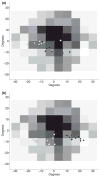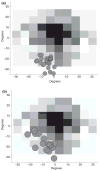Use of multiple preferred retinal loci in Stargardt's disease during natural tasks: a case study
- PMID: 18339049
- PMCID: PMC2848382
- DOI: 10.1111/j.1475-1313.2008.00546.x
Use of multiple preferred retinal loci in Stargardt's disease during natural tasks: a case study
Abstract
Individuals with central visual field loss often use a preferred retinal locus (PRL) to compensate for their deficit. We present a case study examining the eye movements of a subject with Stargardt's disease causing bilateral central scotomas, while performing a set of natural tasks including: making a sandwich; building a model; reaching and grasping; and catching a ball. In general, the subject preferred to use PRLs in the lower left visual field. However, there was considerable variation in the location and extent of the PRLs used. Our results demonstrate that a well-defined PRL is not necessary to adequately perform this set of tasks and that many sites in the peripheral retina may be viable for PRLs, contingent on task and stimulus constraints.
Figures






References
-
- Crossland MD, Culham LE, Rubin GS. Fixation stability and reading speed in patients with newly developed macular disease. Ophthal Physiol Opt. 2004;24:327–333. - PubMed
-
- Crossland MD, Culham LE, Kabanarou SA, Rubin GS. Preferred retinal locus development in patients with macular disease. Ophthalmology. 2005;112:1579–1585. - PubMed
-
- Deruaz A, Whatham AR, Mermoud C, Safran AB. Reading with multiple preferred retinal loci: implications for training a more efficient reading strategy. Vision Res. 2002;42:2947–2957. - PubMed
-
- Deruaz A, Goldschmidt M, Whatham AR, Mermoud C, Lorincz EN, Schnider A, Safran AB. A technique to train new oculomotor behavior in patients with central macular scotomas during reading related tasks using scanning laser ophthalmoscopy: immediate functional benefits and gains retention. BMC Ophthalmol. 2006;6:35. - PMC - PubMed
-
- Duret F, Issenhuth M, Safran AB. Combined use of several preferred retinal loci in patients with macular disorders when reading single words. Vision Res. 1999;39:873–879. Erratum in: 39(16),2793. - PubMed
Publication types
MeSH terms
Grants and funding
LinkOut - more resources
Full Text Sources

